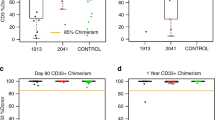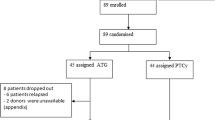Abstract
In this study, we utilized a conditioning regimen with fludarabine and myeloablative dose i.v. BU (12.8 mg/kg) (FluBU) in 36 adult patients (median age: 44 years, range: 18–61) with myeloid or lymphoid malignancies at standard risk (n=10) or high risk of relapse (n=26), who received an allogeneic hematopoietic SCT (HSCT) from HLA-matched related (n=16) or unrelated (n=20) donors. The source of hematopoietic stem cells was peripheral blood in 28 and marrow in 8 cases. Rabbit-antithymocyte globulin at 7 mg/kg was utilized in 21 patients. Acute GVHD grade II–IV was observed in 19% of the patients (grade III–IV in 14% of patients) and chronic GVHD in 11 of 30 evaluable patients (37%). At median follow-up of 737 days (range: 152–1737) for alive patients, overall survival rates in standard- and high-risk patients were 80 and 35%, respectively, and event-free survival rates were 70 and 31%, respectively. TRM was 10% in standard-risk and 19% in high-risk patients. Post transplant relapse was observed in 20% standard-risk and in 46% high-risk patients. FluBU conditioning regimen is associated with a limited hematologic and extrahematologic toxicity and with an antitumor activity comparable to other standard myeloablative regimens.
This is a preview of subscription content, access via your institution
Access options
Subscribe to this journal
Receive 12 print issues and online access
$259.00 per year
only $21.58 per issue
Buy this article
- Purchase on Springer Link
- Instant access to full article PDF
Prices may be subject to local taxes which are calculated during checkout

Similar content being viewed by others
References
Taylor PR, Reid MM, Stark AN, Bown N, Hamilton PJ, Proctor SJ, Northern Region Haematology Group. De novo acute myeloid leukaemia in patients over 55-years-old: a population-based study of incidence treatment and outcome. Leukemia 1995; 9: 231–237.
Martino R, Guardia R, Altes A, Sureda A, Brunet S, Sierra J . Time sequential chemotherapy for primary refractory or relapsed adult acute myeloid leukemia: results of the phase II Gemia protocol. Haematologica 1999; 84: 226–230.
Leopold LH, Willemze R . The treatment of acute myeloid leukemia in first relapse: a comprehensive review of the literature. Leuk Lymphoma 2002; 43: 1715–1727.
Leith CP, Kopecky KJ, Godwin J, McConnell T, Slovak ML, Chen IM et al. Acute myeloid leukemia in the elderly: assessment of multidrug resistance (MDR1) and cytogenetics distinguishes biologic subgroups with remarkably distinct responses to standard chemotherapy. A Southwest Oncology Group study. Blood 1997; 89: 3323–3329.
Thomas E, Storb R, Clift RA, Fefer A, Johnson FL, Neiman PE et al. Bone-marrow transplantation (first of two parts). N Engl J Med 1975; 292: 832–843.
Barrett AJ, Savani BN . Stem cell transplantation with reduced-intensity conditioning regimens: a review of ten years experience with new transplant concepts and new therapeutic agents. Leukemia 2006; 20: 1661–1672.
Bacigalupo A, Vitale V, Corvo R, Barra S, Lamparelli T, Gualandi F et al. The combined effect of total body irradiation (TBI) and cyclosporin A (CyA) on the risk of relapse in patients with acute myeloid leukaemia undergoing allogeneic bone marrow transplantation. Br J Haematol 2000; 108: 99–104.
Russell JA, Tran HT, Quinlan D, Chaudhry A, Duggan P, Brown C et al. Once-daily intravenous busulfan given with fludarabine as conditioning for allogeneic stem cell transplantation: study of pharmacokinetics and early clinical outcomes. Biol Blood Marrow Transplant 2002; 8: 468–476.
Bornhauser M, Storer B, Slattery JT, Appelbaum FR, Deeg HJ, Hansen J et al. Conditioning with fludarabine and targeted busulfan for transplantation of allogeneic hematopoietic stem cells. Blood 2003; 102: 820–826.
de Lima M, Couriel D, Thall PF, Wang X, Madden T, Jones R et al. Once-daily intravenous busulfan and fludarabine: clinical and pharmacokinetic results of a myeloablative, reduced-toxicity conditioning regimen for allogeneic stem cell transplantation in AML and MDS. Blood 2004; 104: 857–864.
McDonald GB, Slattery JT, Bouvier ME, Ren S, Batchelder AL, Kalhorn TF et al. Cyclophosphamide metabolism, liver toxicity, and mortality following hematopoietic stem cell transplantation. Blood 2003; 101: 2043–2048.
Chunduri S, Dobogai LC, Peace D, Saunthararajah Y, Chen HY, Mahmud N et al. Comparable kinetics of myeloablation between fludarabine/full-dose busulfan and fludarabine/melphalan conditioning regimens in allogeneic peripheral blood stem cell transplantation. Bone Marrow Transplant 2006; 38: 477–482.
Bonifazi F, Bandini G, Rondelli D, Falcioni S, Stanzani M, Bontadini A et al. Reduced incidence of GVHD without increase in relapse with low-dose rabbit ATG in the preparative regimen for unrelated bone marrow transplants in CML. Bone Marrow Transplant 2003; 32: 237–242.
Bonifazi F, Bandini G, Stanzani M, Palandri F, Giannini B, Arpinati M et al. In vivo T-cell depletion with low-dose ATG is effective in reducing cGVHD after peripheral blood stem cell myeloablative sibling transplants in CML: results from a prospective phase II study. Bone Marrow Transplant 2005; 35: 1025–1026.
Thiede C, Florek M, Bornhauser M, Ritter M, Mohr B, Brendel C et al. Rapid quantification of mixed chimerism using multiplex amplification of short tandem repeat markers and fluorescence detection. Bone Marrow Transplant 1999; 23: 1055–1060.
Przepiorka D, Weisdorf D, Martin P, Klingemann HG, Beatty P, Hows J et al. 1994 Consensus Conference on Acute GVHD Grading. Bone Marrow Transplant 1995; 15: 825–828.
Sullivan KM, Agura E, Anasetti C, Appelbaum F, Badger C, Bearman S et al. Chronic graft-versus-host disease and other late complications of bone marrow transplantation. Semin Hematol 1991; 28: 250–259.
Byrd JC, Mrozek K, Dodge RK, Carroll AJ, Edwards CG, Arthur DC et al. Pretreatment cytogenetic abnormalities are predictive of induction success, cumulative incidence of relapse, and overall survival in adult patients with de novo acute myeloid leukemia: results from Cancer and Leukemia Group B (CALGB 8461). Blood 2002; 100: 4325–4336.
Jurado M, Deeg HJ, Storer B, Anasetti C, Anderson JE, Bryant E et al. Hematopoietic stem cell transplantation for advanced myelodysplastic syndrome after conditioning with busulfan and fractionated total body irradiation is associated with low relapse rate but considerable nonrelapse mortality. Biol Blood Marrow Transplant 2002; 8: 161–169.
Geller RB, Devine SM, O'Toole K, Persons L, Keller J, Mauer D et al. Allogeneic bone marrow transplantation with matched unrelated donors for patients with hematologic malignancies using a preparative regimen of high-dose cyclophosphamide and fractionated total body irradiation. Bone Marrow Transplant 1997; 20: 219–225.
Santos GW, Tutschka PJ, Brookmeyer R, Saral R, Beschorner WE, Bias WB et al. Marrow transplantation for acute nonlymphocytic leukemia after treatment with busulfan and cyclophosphamide. N Engl J Med 1983; 309: 1347–1353.
Tutschka PJ, Copelan EA, Klein JP . Bone marrow transplantation for leukemia following a new busulfan and cyclophosphamide regimen. Blood 1987; 70: 1382–1388.
Wallen H, Gooley TA, Deeg HJ, Pagel JM, Press OW, Appelbaum FR et al. Ablative allogeneic hematopoietic cell transplantation in adults 60 years of age and older. J Clin Oncol 2005; 23: 3439–3446.
Tauro S, Craddock C, Peggs K, Begum G, Mahendra P, Cook G et al. Allogeneic stem-cell transplantation using a reduced-intensity conditioning regimen has the capacity to produce durable remissions and long-term disease-free survival in patients with high-risk acute myeloid leukemia and myelodysplasia. J Clin Oncol 2005; 23: 9387–9393.
Popat U, Heslop HE, Durett A, May R, Krance RA, Brenner MK et al. Outcome of reduced-intensity allogeneic hematopoietic stem cell transplantation (RISCT) using antilymphocyte antibodies in patients with high-risk acute myeloid leukemia (AML). Bone Marrow Transplant 2006; 37: 547–552.
Rondelli D, Barosi G, Bacigalupo A, Prchal JT, Popat U, Alessandrino EP et al. Allogeneic hematopoietic stem-cell transplantation with reduced-intensity conditioning in intermediate- or high-risk patients with myelofibrosis with myeloid metaplasia. Blood 2005; 105: 4115–4119.
Shimoni A, Hardan I, Shem-Tov N, Yeshurun M, Yerushalmi R, Avigdor A et al. Allogeneic hematopoietic stem-cell transplantation in AML and MDS using myeloablative versus reduced-intensity conditioning: the role of dose intensity. Leukemia 2006; 20: 322–328.
Russell JA, Turner AR, Larratt L, Chaudhry A, Morris D, Brown C et al. Adult recipients of matched related donor blood cell transplants given myeloablative regimens including pretransplant antithymocyte globulin have lower mortality related to graft-versus-host disease: a matched pair analysis. Biol Blood Marrow Transplant 2007; 13: 299–306.
Bacigalupo A, Lamparelli T, Barisione G, Bruzzi P, Guidi S, Alessandrino PE et al. Thymoglobulin prevents chronic graft-versus-host disease, chronic lung dysfunction, and late transplant-related mortality: long-term follow-up of a randomized trial in patients undergoing unrelated donor transplantation. Biol Blood Marrow Transplant 2006; 12: 560–565.
Author information
Authors and Affiliations
Corresponding author
Rights and permissions
About this article
Cite this article
Chunduri, S., Dobogai, L., Peace, D. et al. Fludarabine/i.v. BU conditioning regimen: myeloablative, reduced intensity or both?. Bone Marrow Transplant 41, 935–940 (2008). https://doi.org/10.1038/bmt.2008.13
Received:
Revised:
Accepted:
Published:
Issue Date:
DOI: https://doi.org/10.1038/bmt.2008.13
Keywords
This article is cited by
-
Renal dysfunction within 90 days of FluBu4 predicts early and late mortality
Bone Marrow Transplantation (2019)
-
Addition of melphalan to fludarabine/busulfan (FLU/BU4/MEL) provides survival benefit for patients with myeloid malignancy following allogeneic bone-marrow transplantation/peripheral blood stem-cell transplantation
International Journal of Hematology (2019)
-
Similar survival but increased toxicity with a sequential versus concurrent FluBu4 regimen
Bone Marrow Transplantation (2018)
-
Pretransplant conditioning with fludarabine and IV busulfan, reduced toxicity and increased safety without compromising antitumor efficacy and overall treatment effect?
Bone Marrow Transplantation (2016)
-
Decreased pulmonary function in asymptomatic long-term survivors after allogeneic hematopoietic stem cell transplant
Bone Marrow Transplantation (2016)



